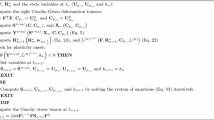Abstract
In the present paper, a finite strain model for complex combined isotropic-kinematic hardening is presented. It accounts for finite elastic and finite plastic strains and is suitable for any anisotropic yield criterion. In order to model complex cyclic hardening phenomena, the kinematic hardening is described by several back stress components. To that end, a new procedure is proposed in which several multiplicative decompositions of the plastic part of the deformation gradient are considered. The formulation incorporates a completely general format of the yield function, which means that any yield function can by employed by following a procedure that ensures the principle of material frame indifference. The constitutive equations are derived in a thermodynamically consistent way and numerically integrated by means of a backward-Euler algorithm based on the exponential map. The performance of the constitutive model is assessed via numerical simulations of industry-relevant sheet metal forming processes (U-channel forming and draw/re-draw of a panel benchmarks), the results of which are compared to experimental data. The comparison between numerical and experimental results shows that the use of multiple back stress components is very advantageous in the description of springback. This holds in particular if one carries out a comparison with the results of using only one component. Moreover, the numerically obtained results are in excellent agreement with the experimental data.

















Similar content being viewed by others
References
Papadopoulos P, Lu J (2001) On the formulation and numerical solution of problems in anisotropic finite plasticity. Comput Methods Appl Mech Eng 190:4889–4910
Löblein J, Schröder J, Gruttmann F (2003) Application of generalized measures to an orthotropic finite elasto-plasticity model. Comput Mater Sci 28:696–703
Miehe C, Apel N (2004) Anisotropic elastic-plastic analysis of shells at large strains. A comparison of multiplicative and additive approaches to enhanced finite element design and constitutive modelling. Int J Numer Meth Eng 61:2067–2113
Ulz MH (2009) A Green-Naghdi approach to finite anisotropic rate-independent and rate-dependent thermo-plasticity in logarithmic Lagrangean strain-entropy space. Comput Methods Appl Mech Eng 198:3262–3277
Menzel A, Steinmann P (2003) On the spatial formulation of anisotropic multiplicative elasto-plasticity. Comput Methods Appl Mech Eng 192:3431–3470
Sansour C, Karšaj I, Sorić J (2006) A formulation of anisotropic continuum elastoplasticity at finite strains. Part I: modelling. Int J Plast 22:2346–2365
Vladimirov IN, Pietryga MP, Reese S (2010) Anisotropic finite elastoplasticity with nonlinear kinematic and isotropic hardening and application to sheet metal forming. Int J Plast 26:659–687
Shi B, Mosler J (2013) On the macroscopic description of the yield surface evolution by means of distortional hardening models: Application to magnesium. Int J Plast 44:1–22
Cazacu O, Barlat F (2004) A criterion for description of anisotropy and yield differential effects in pressure-insensitive metals. Int J Plast 20:2027–2045
Grilo TJ (2015) Development of computational anisotropic hypoelastic—and hyperelastic-based models including nonlinear kinematic hardening. PhD. Thesis, University of Aveiro
Dettmer W, Reese S (2004) On the theoretical and numerical modelling of Armstrong-Frederick kinematic hardening in the finite strain regime. Comput Methods Appl Mech Eng 193:87–116
Lührs G, Hartmann S, Haupt P (1997) On the numerical treatment of finite deformations in elastoviscoplasticity. Comput Methods Appl Mech Eng 144:1–21
Tsakmakis C (1996) Kinematic hardening rules in finite plasticity. Part I: a constitutive approach. Contin Mech Thermodyn 8:215–231
Tsakmakis C, Willuweit A (2004) A comparative study of kinematic hardening rules at finite deformations. Int J Nonlin Mech 39:539–554
Armstrong PJ, Frederick CO (1966) A mathematical representation of the multiaxial bauschinger effect. Central Electricity Generating Board Report, Berkeley Nuclear Laboratories, RD/B/N 731
Freund M, Shutov AV, Ihlemann J (2012) Simulation of distortional hardening by generalizing a uniaxial model of finite strain viscoplasticity. Int J Plast 36:113–129
Lion A (2000) Constitutive modelling in finite thermoviscoplasticity: a physical approach based on nonlinear rheological models. Int J Plast 16:469–494
Vladimirov IN, Pietryga MP, Reese S (2008) On the modelling of non-linear kinematic hardening at finite strains with application to springback—comparison of time integration algorithms. Int J Numer Meth Eng 75:1–28
Chaboche JL, Rousselier G (1983) On the plastic and viscoplastic constitutive equations—Part I: rules development with internal variable concept. J Press Vess Technol 105:153–158
Wallin M, Ristinmaa M (2005) Deformation gradient based kinematic hardening model. Int J Plast 21:2025–2050
Barlat F, Aretz H, Yoon JW, Karabin ME, Brem JC, Dick RE (2005) Linear transformation-based anisotropic yield functions. Int J Plast 21:1009–1039
Miehe C (1996) Numerical computation of algorithmic (consistent) tangent moduli in large-strain computational inelasticity. Comput Methods Appl Mech Eng 134:223–240
NUMISHEET (1993) Numisheet’93 benchmark problem. In: Makinouchi A, Nakamachi E, Onate E, Wagoner RH (eds) Proceedings of 2nd international conference on numerical simulation of 3D sheet metal forming processes—verification of simulation with experiment, Isehara
Lee JW, Lee MG, Barlat F (2012) Finite element modeling using homogeneous anisotropic hardening and application to spring-back prediction. Int J Plast 29:13–41
Grilo TJ, Souto N, Valente RAF, Andrade-Campos A, Thuillier S, Alves de Sousa RJ (2013) On the development and computational implementation of complex constitutive models and parameters’ identification procedures. Key Eng Mat 554–557:936–948
Carsley JE, Xia C, Yang L, Stoughton TB, Xu S, Hartfield-Wünsch SE, Li J, Chen Z (2013) Benchmark 2—springback of a draw / re-draw panel: Part A: benchmark description. AIP Conf Proc 1567:177–182
Stoughton TB, Shi MF, Huang G, Yoon JW (2013) Material characterizations for benchmark 1 and benchmark 2. AIP Conf Proc 1567:9–14
Acknowledgments
The authors acknowledge the financial support by the grants SFRH/BD/82286/2011 and PTDC/ EME-TME/115876/2009 from the Fundação para a Ciência e a Tecnologia, Ministerio da Educação e Ciência (Portugal).
Author information
Authors and Affiliations
Corresponding author
Rights and permissions
About this article
Cite this article
Grilo, T.J., Vladimirov, I.N., Valente, R.A.F. et al. On the modelling of complex kinematic hardening and nonquadratic anisotropic yield criteria at finite strains: application to sheet metal forming. Comput Mech 57, 931–946 (2016). https://doi.org/10.1007/s00466-016-1270-6
Received:
Accepted:
Published:
Issue Date:
DOI: https://doi.org/10.1007/s00466-016-1270-6




